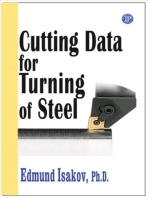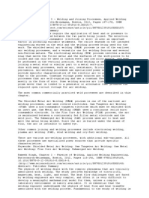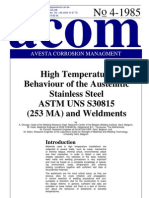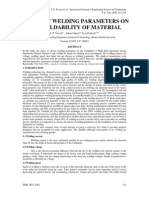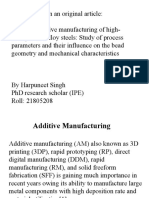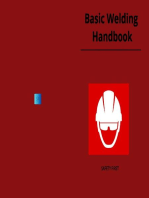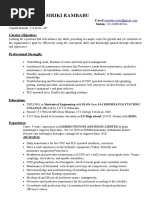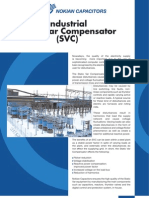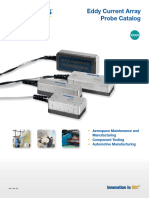Titipan Zahra
Titipan Zahra
Uploaded by
DikaAfriandiCopyright:
Available Formats
Titipan Zahra
Titipan Zahra
Uploaded by
DikaAfriandiCopyright
Available Formats
Share this document
Did you find this document useful?
Is this content inappropriate?
Copyright:
Available Formats
Titipan Zahra
Titipan Zahra
Uploaded by
DikaAfriandiCopyright:
Available Formats
American Journal of Mechanical Engineering, 2016, Vol. 4, No.
3, 92-98
Available online at http://pubs.sciepub.com/ajme/4/3/2
Science and Education Publishing
DOI:10.12691/ajme-4-3-2
An Investigation into Effect of Butt Welding Parameters
on Weldment Mechanical Properties
A. Hemaid, Tarik Tawfeek*, O. A. Gaheen
Mechanical Engineering Department, Faculty of Engineering, Benha University, Cairo, Egypt
*Corresponding author: tariktewfic@yahoo.co.uk
Abstract Butt Fusion is the most important welding technique used for joining materials of similar compositions
and melting points, resulting in welded joints as strong as the materials itself. The principle of butt fusion is to heat
the materials ends to a designated temperature under pressure for a specified amount of time, then the materials ends
are fused together under pressure for a period of time. In the present work a set of experiments has been conducted
on base material of steel 52-3N (DIN 17100) to study the effect of butt welding process variables on the temperature
distributions, welding thermal cycles behavior, peak temperature and the cooling rate for the steel butt-welding joints
in the multiple pass welding process by means of the practically measurements. Also the effect of heat input which
presented by the welding process variables on the mechanical properties of the welded joints has been investigated
to reach the optimum welding variables which give the optimum mechanical properties. It is observed through the
experiments that the optimum mechanical properties can be achieved at interpass temperature of 200, welding
voltage of 35V and welding speed of 6 mm/sec.
Keywords: Wire feed rate, Welding speed, Interpass temperature, Arc voltage, HAZ, Gas Metal Arc Welding
(GMAW)
Cite This Article: A. Hemaid, Tarik Tawfeek, and O. A. Gaheen, An Investigation into Effect of Butt
Welding Parameters on Weldment Mechanical Properties. American Journal of Mechanical Engineering, vol. 4,
no. 3 (2016): 92-98. doi: 10.12691/ajme-4-3-2.
1. Introduction
In the fusion welding processes, part edges or joint
faying surfaces are heated to above the melting point for a
pure material. All fusion welds contain a distinct fusion
zone (FZ), as well as heat- affected zones (HAZ) and
unaffected base material. In alloys, there is also a partially
melted zone (PMZ) between the FZ and HAZ [1].
Thermal cycle of one weld pass where the high heat
input gives low cooling rate and the low heat input gives
high cooling rate. The cooling rate affects directly on the
microstructure and the properties of the welded joint. The
heat input depends on the welding voltage, current, and
speed. The effect of varying the heat input, between 0.6
and 4.3 KJ/mm, on the microstructure and properties of
manual metal arc deposits containing 0.6-18 Manganese
(Mn) has been investigated in [2,3].
Reference [4] presented results of a study aimed to
establish temperature distribution, distortion, and residual
stress field developed during the welding process in
welded aluminum plates. The material considered was of
AL-2024-T3, commonly used for aircraft components. A
numerical analysis of welding process using finite element
method (FEM) was carried out. Numerical results were
compared with experimental test, and good agreement is
obtained.
Reference [5] studied the evolution of temperature and
velocity field during gas tungsten arc spot welding of AISI
1005 steel by using a transient numerical model. The
sensitivity of weldmetal microstructure and mechanical
properties to variations in both heat input and weld
dilution in submerged arc (SA) welding of micro alloyed
steel was examined as in [6]. Weldments were prepared
with weld metal dilutions of approximately 40% and 70%
at heat input of 2.0, 3.3, 4.6, and 5.3 kJ/mm, using two
commercial welding wires and a basic commercial flux.
The high dilution welds, which were ordinary bead on
plate welds, resulted in microstructures that ranged from
ferrite with aligned second phase at low heat input to
acicular ferrite at high heat inputs. Special over- welding
techniques were used to make the low dilution welds,
allowing use of the same welding parameters as those for
the high dilution welds.
Reference [7] described derivation of a control model
for electrode melting and heat and mass transfer from the
electrode to the workpiece in gas metal arc welding
(GMAW). Specifically, a model is developed which
allows electrode speed and welding speed to be calculated
for given values of voltage and torch-to-base metal
distance, as a function of the desired heat and mass input
to the weldment. Heat input is given on a per unit weld
length basis, and mass input is given in terms of transverse
cross- sectional area added to the weld bead (termed
reinforcement). The relationship to prior work is discussed.
A range of semiautomatic gas-shield arc welding
consumables was selected as in [8], in order to assess their
suitability for producing uphill groove welds in 30mm
thick structural steel. In addition to 1.2mm diameter solid
93
American Journal of Mechanical Engineering
welding wire, 1.2mm diameter rutile and basic flux cored
and metal cored welding wire were employed, all with Ar20%CO2 shielding. A 2mm diameter self shielded flux
cored welding wire was also included. All deposits
contained nominally 1%Ni. Constant voltage power
sources were used for the rutile and self-shield electrodes,
and synergic pulsed power sources for the remainder. All
welding was carried out without preheat, and with a
maximum interpass temperature of 150C.
References [9,10,11] studied a three AWS Code, all
weld-metal test assemblies were welded with an E11018-M
electrode from a standard production batch, varying the
welding parameters in such a way as to obtain three
energy inputs: high heat input and high interpass
temperature , medium heat input and medium interpass
temperature, and low heat input and low interpass
temperature. Mechanical properties and metallographic
studies were performed in the as welded condition.
Reference [12] present the effect of heat input on the
microstructure and mechanical properties of the heat
affected zone of duplex steel. He studied the effect of the
heat input on the microstructural changes and the impact
properties. On the other hand, heat transfer calculations
were absent, and its computer model. Also there is no
temperature distribution in 3-D, thermal cycle in the 2-D,
the NDTs for the welded joint, and empirical coloration.
Reference [13] presents an effect of the number of
passes on the structure and properties of submerged arc
welds of AISI type 316L stainless steel. He proof that as
the number of passes increased, the hardness and tensile
strength increased, while the ductility and toughness
decreased.
The present work aims to study the effect of welding
process variables (interpass temperature, welding power,
welding speed, and welding position) on the temperature
distributions, the welding thermal cycles behavior, peak
temperature and the cooling rate for the steel butt-welding
joints in the multiple pass welding process by means of
the practically measurements
Also, it aims to study practically the effect of heat input
which presented by the welding process variables on the
mechanical properties (tensile strength, yield strength,
surface hardness, and impact test) of the welded joints to
reach the optimum welding variables which give the
optimum mechanical properties.
2.2. The Electrode Specifications
According to the ESAB Welding Handbook [14] the
used electrode specifications and classification are shown
in Table 3, Table 4 and Table 5.
Wire Classification
DIN 8559
SG3
C%
Table 3. Welding data ranges
Welding
Arc Voltage
Current
Positions
V
A
1G & 3G
18-35
Wire feed
m/min
120-380
2.3-15
Table 4. The wire chemical compositions %
Si%
Mn%
0.1
0.85
1.5
Table 5. The wire mechanical properties
Tensile Strength
Yield Stress
Elongation
620 N/mm
470 N/mm
25%
2.3. Preparation of the Welding Joints
Two plates of size 200x100 mm with thickness 10 mm,
each with one of the edges chamfered by machining, were
taken together to form a weld pad of size 200x200 mm
with a S-V- groove joint, Figure 1, and Figure 2 shows the
Single-V- groove weld, butt weld joint (B), and
prequalified complete joint penetration (CJP) groove
welded joint details. Table 1 dives all the data and
specifications for the base metal.
The related steel strips were cut to size using band saw.
Figure 1. Welded joint details of S-V-groove butt weld (1G position)
according to AWS code
2. Experimental Work
2.1. The Base Metal Specifications
According to the Egyptian Iron and Steel Co. Hadisolb
[13] the base metal specifications used are shown in Table 1
and Table 2.
Table 1. The chemical compositions of the base metal
Steel Grade
C%
Mn%
Si%
P%
S%
DIN 17100
max
Max
Max
max
max
St. 52-3N
0.23
1.70
0.60
0.045
0.045
N%
max
0.011
Table 2. The mechanical properties of the base metal
Steel Grade
Tensile Strength
Upper Yield Point
Elongation %
DIN 17100
N/mm
N/mm
St. 52-3N
610
460
22%
Figure 2. Prequalified CJP of S-V-groove butt weld for the present work
American Journal of Mechanical Engineering
94
Figure 3. Thermocouples locations and distances between them for the
present experimental work in the two-dimension
2.4. Welding Variables
Interpass temperature: The interpass temperature is the
temperature immediately before each weld run after the
first is deposited. The interpass temperatures were varied
in the present work between 50 and 500C.
Welding Power: The variation in the welding power
was produced by the consumed voltage and current during
the welding process. Figure 4-Figure 6 shows the power
registered through the values of the volt and ampere on the
screen of the welding machine in the GMAW process. The
welding powers were varied in the present work between
2.6 to 9.9 k W.
Figure 4. Thermocouples locations in the weld test plate practically in
the two-dimension
Figure 5. Thermocouples connections with the A/D C modules in the
present experimental work
Figure 6. Ethernet interface for compact field point
Welding Speed:The welding speed or the travel speed
of the welding arc is a function in the wire feed rate of the
GMAW machine. The wire feed rate ranges affect on the
arc speed directly and were varied in the present work
between 3 to 9 mm/sec.
2.5. Temperature Measurement Technique
The welding thermal cycles were recorded with a
computer based data acquisition system, using five K-type
thermocouples calibrated with certification come from
EAST company (2.5 mm in diameter, Nickel-Chromium,
grade from -200 to 1250 C, standard error 2.2C above
0C, and thermoelectric voltage 0:10 mill volts). The
thermocouples are used to measure the temperature
distribution during welding. The thermocouples were
fixed in the plate to measure the temperature in the twodimension (x-y plane) as shown in Figure 3 and Figure 4.
The temperature were measured at distances 12, 19.5, and
27 mm from the weld centerline on one side plate only at
the center plate, for the sensor numbers 4,3, and 2
respectively. And 12mm from the weld centerline for the
sensor numbers 1, and 5 at the two edges of the plat at the
top surface of the test plate.
The NI cFP- TC120 module built-in signal compensation
(data logger or data acquisition) includes eight differential
inputs for thermocouples, resolution of 16 bits resolution
for high-accuracy measurements, sample rate 1000
sample/sec, and analog to digital conversion. It also
provides cold junction compensation using a thermistor
embedded in the connector block.
Figure 7. Thermocouples locations and distances between them for the
present experimental work in the three-dimension at three points P1,P2,
and P3
95
American Journal of Mechanical Engineering
Figure 5 and Figure 6 show the ethernet interface for
compact field point and the thermocouples module
connection. The NI cFP- TC120 module which used in the
measurements is come from EAST Company. Figure 7
and Figure 8 show the thermocouples locations in the
plate used to measure the temperature in the threedimension (x-y-z).
2.6.1. Tension Test Specimen
According to the ASTM code the tension test specimen
dimensions are shown in Figure 10. The transverse weld
specimens are used to study the effect of welding
variables on the mechanical properties. On the other hand,
the longitudinal weld specimens are used to study the
effect of artificial porosity on the tensile and yield strength
under multi thermal cycles.
Figure 8. Thermocouples locations in the weld test plate practically in
the three-dimension
2.6. Tension and Impact Test Specimens
The specimens of the tension and charpy V-notch
impact tests are taken from the welded joints which are
welded according to special conditions. These specimens
are taken by machining according to ASTM code [15].
The locations of these specimens are shown in Figure 9.
The transverse weld specimens for tension and charpy
V-notch impact test are used for evaluation of all welded
joints with different welding variables. On the other hand,
the longitudinal weld specimens for tension test are used
only for evaluation the welded joints containing artificial
porosity at different heat input conditions. The distractive
tests are carried out in the Faculty of Engineering at Shoubra.
Figure 10. Dimensions of tension and impact test specimen according to
ASTM code
2.6.2. Charpy V-Notch Impact Specimen
According to the ASTM code the charpy V-notch
impact test specimen dimensions are shown in the Figure
10 also. These specimens are used to study the effect of
welding variables on the mechanical properties.
3. Results and Discussions
Input Variables and Their Limits
The independently controllable input parameters affecting
the tensile strength were arc voltage (V), wire feed rate (F),
welding speed (S), and interpass temperature (T). Trial
runs were carried out by varying one of the input parameters
while keeping the rest at constant values. The input variables
and their limits in coding form are given in Table 6.
Table 6. welding conditions and their limits
Limits in code form
Welding Parameters
Units
Sym
-2
-1
0
+1
+2
Arc voltage
Volts
20
25
30
35
40
Wire feed rate
m/min
11
Welding speed
mm/sec
10
Interpass temperature
100
200
300
400
500
3.1. Experimental Data
Figure 9. Locations of the tension and impact test specimen according to
ASTM code
The selected design matrix shown in Table 7 is a fivelevels for each factor. All welding variables at their
intermediate level (0).
American Journal of Mechanical Engineering
Table 7. Design matrix and their response
Input Variables
Coded Variables
WFR
Volt
Speed
Temp
3
5
7
9
11
7
7
7
7
7
7
7
7
7
7
7
7
7
7
7
30
30
30
30
30
20
25
30
35
40
30
30
30
30
30
30
30
30
30
30
6
6
6
6
6
6
6
6
6
6
2
4
6
8
10
6
6
6
6
6
300
300
300
300
300
300
300
300
300
300
300
300
300
300
300
100
200
300
400
500
-2
-1
0
1
2
0
0
0
0
0
0
0
0
0
0
0
0
0
0
0
0
0
0
0
0
-2
-1
0
1
2
0
0
0
0
0
0
0
0
0
0
0
0
0
0
0
0
0
0
0
0
-2
-1
0
1
2
0
0
0
0
0
0
0
0
0
0
0
0
0
0
0
0
0
0
0
0
-2
-1
0
1
2
96
Responses
T =(10
N/mm2 )
56.266
52.066
48.866
54.9
54.566
45
48.466
47.6
57.666
48.933
49.033
48.7
50.733
48.866
44.933
49.266
51.866
50.5
49.166
48
Figure 11-2. Effect of wire feed rate and welding voltage on the tensile
strength at S=4mm/sec, and T=200 C
3.2. Effect of Wire Feed Rate and Welding
Voltage
The empirical correlation is useful in prediction of the
tensile strength at different welding variables. Figure (11-1),
(11-2), (11-3), (11-4), (11-5) show the predicted effect of
the wire feed rate of the welding electrode at 3m/min,
5m/min, 7m/min, 9m/min, and 11m/min on the tensile
strength of the joint before welding at different welding
voltage of 20V, 25V, 30V, 35V, and 40V and at welding
speed of 2mm/sec, 4mm/sec, 6mm/sec, 8mm/sec, and
10mm/sec, and interpass temperature of 100C, 200C,
300C, 400C, and 500C . The result shows that the
tensile strength decreases with the increasing of the wire
feed rate, welding speed, and interpass temperature at any
constant value of welding voltage. On the other hand, the
tensile strength increases with welding voltage increases
also at any value of the wire feed rate, welding speed, and
interpass temperature.
Figure 11-1. Effect of wire feed rate and welding voltage on the tensile
strength at S=2mm/sec, and T=100 C
Figure 11-3. Effect of wire feed rate and welding voltage on the tensile
strength at S=6mm/sec, and T=300 C
Figure 11-4. Effect of wire feed rate and welding voltage on the tensile
strength at S=8mm/sec, and T=400 C
97
American Journal of Mechanical Engineering
Figure 11-5. Effect of wire feed rate and welding voltage on the tensile
strength at S=10mm/sec, and T=500 C
3.3. Effect of Welding Speed And Welding
Voltage
Figure 12-2. Effect of welding voltage and welding speed on the tensile
strength at WFR=5m/min, and T=200 C
The empirical correlation is useful in the prediction of the
tensile strength at different welding variables. Figure (12-1),
Figure (12-2), Figure (12-3), Figure (12-4), Figure (12-5)
show the predicted effect of the welding voltage of the
welding electrode voltage of 20V, 25V, 30V, 35V, and
40V on the tensile strength of the joint before welding at
different welding speed of 2mm/sec, 4mm/sec, 6mm/sec,
8mm/sec, and 10mm/sec at wire feed rate of the welding
electrode of 3m/min, 5m/min, 7m/min, 9m/min, and
11m/min, and interpass temperature of 100C, 200C,
300C, 400C, and 500Cthe result show that with the
increasing in the welding voltage the tensile strength
increases also. On the other hand, the tensile strength
decreases with increasing in the welding speed, wire feed
rate, and interpass temperature at any constant value of the
welding voltage.
Figure 12-3. Effect of welding voltage and welding speed on the tensile
strength at WFR=7m/min, and T=300 C
Figure 12-1. Effect of welding voltage and welding speed on the tensile
strength at WFR=3m, a/min, and T=100 C
Figure 12-4. Effect of welding voltage and welding speed on the tensile
strength at WFR=9m/min, and T=400 C
American Journal of Mechanical Engineering
98
- Although the artificial porosity in the welded joint
was accepted, the tensile and yield strengths of the welded
joint decreased with the increasing in the welding heat
input.
- Through the experimental data which taken by the
destructive tests the predicted tensile strength can be
obtained from the following empirical equation within the
application limits;
U = 29.48* F 0.045V 0.212 * S 0.0158 * T 0.013
avr = 4.9%
Figure 12-5. Effect of welding voltage and welding speed on the tensile
strength at WFR=11m/min, and T=500 C
4. Conclusons
- For the steel plates of 10mm thickness the twodimensional temperature distributions may be good
approximation instead of the three-dimensional for the
temperature distribution.
- For the steel structure field it prefer the gap between
weld pass within 50sec it means for the long welding joint
it must be use more than one welding machine to keep the
time gap be constant.
References
[1]
The results of studying the effect of welding parameters
(interpass temperature, welding power, welding speed,
and welding position) which presented in the heat input on
the temperature distribution in three-dimension, and twodimension, and the mechanical properties of the steel
welded joints by GMAW came out with the following
conclusions.
- Increasing the heat input in the welding process by the
welding variables leaded to a welding joint which has less
mechanical prosperities than the base metal prosperities.
- Increasing the heat input in the welding process by the
welding variables increase the heat accumulation during
the welding process, increases the peak temperature in the
thermal cycles, and decreases the cooling rate.
-The error due to two-dimensional approximation in the
heat transfer analysis of welding process thermal cycle is
10.7% for the first and second pass, and 27% for the third
pass.
- Through the welding variables values which give the
optimum mechanical properties, it is easy to predict the
quality of the joint by following these values during the
welding process.
- The optimum mechanical properties take place at
interpass temperature of 200.
- The optimum mechanical properties take place at
welding voltage of 35V.
- The best mechanical properties take place at welding
speed of 6 mm/sec.
- The optimum mechanical properties take place at
welding position of 3G-up and 1G.
[2]
[3]
[4]
[5]
[6]
[7]
[8]
[9]
[10]
[11]
[12]
[13]
Evans G. M. and Bailey N., "Metallurgy of Basic Weld Metal",
Abington Publishing, 1997.
Evans G. M., "The effect of heat input on the microstructure and
properties of C-Mn all weld metal deposits" Welding Industries
Oerlicon Buehrle Ltd., Zurich Switzerland 1982.
Ahmed Faraz, Salman Nisar, Mohammad Amir Khan,Effect of
Welding Parameterson the Structural Performance of Fusion
Welding Extruded and Injection Molded HDPE Joints. Journal of
space technology, Vol-4, No-1,July2014.
Meo M. and Vignjevic R., "Welding simulation using FEA"
Welding Journal, AWS, pp. 59-64, 2000.
Zhang W., Roy G. G., Elmer J. W., and DebRoy T., "Modeling of
heat transfer and fluid flow during gas tungsten arc spot welding
of low carbon steel", American Institute of Physics, Journal of
Applied Physics, Vol. 93, pp. 3022-3033, 2003.
Hunt A. C., Kluken A. O. and Edwards G. R., "Heat input and
dilution effects in microalloyed steel weld metals" Welding and
Joining Research, Colorado School, pp. 9-s to 15-s, 1994.
Smartt H. B. and Einerson C. J.," A model for hear and mass input
control in GMAW", Idaho, pp. 217-s to 229-s, 1993.
Abson D. J., "Microstructure and mechanical properties of gasshielded welding of C-Mn-Ni steel", Cambridge University,
Welding Journal, AWS, pp. 173-s to 187s, 1990.
Jose Vercesi and Estela Surian, "The effect of welding parameters
on high-strength SMAW all-weld-metal-part1: AWS E11018-M",
Buenos Aires, Argentina, Welsing Research, pp. 191s to 196s,
1996.
Egyptian Iron & Steel Co. Hadisolb "Company Profile and
product specifications", 2007.
ANSI/AWS "Structural Welding Code-Steel" 16th Edition,
American Welding Society, 2005.
James G., john B., Don Baragar and Murray Lrtts, "Gleeble
simulation studies at MTL-CANMET", Ottawa Ontario Canada,
pp. 21-24, 2000.
Gowrisankar I., Bhaduri A. K., Verma D. D. N., and Achar D. R.
G., "Effect of the number of passes on the structure and properties
of submerged arc welds of AISI type 316L stainless steel",
Welding Research, India, pp. 147s to 154s, 1987.
You might also like
- Toyota Celica Wiring Diagram 1993Document18 pagesToyota Celica Wiring Diagram 1993Gary Reynolds100% (2)
- Statement of PurposeDocument1 pageStatement of PurposenaveedchouhanNo ratings yet
- Study On Effect of Manual Metal Arc Welding Process Parameters On Width of Heat Affected Zone (Haz) For Ms 1005 SteelDocument8 pagesStudy On Effect of Manual Metal Arc Welding Process Parameters On Width of Heat Affected Zone (Haz) For Ms 1005 SteelIJMERNo ratings yet
- Optimizing Tensile Strength of Low-Alloy Steel Joints in Upset WeldingDocument5 pagesOptimizing Tensile Strength of Low-Alloy Steel Joints in Upset Weldingabraham silva hernandezNo ratings yet
- RESEARCH PAPER FinalDocument7 pagesRESEARCH PAPER Final7as1940206No ratings yet
- Soldagem InoxDocument10 pagesSoldagem InoxEdenilson BotelhoNo ratings yet
- AISI 430 Ferritic Stainless Steel MicrostuctureDocument7 pagesAISI 430 Ferritic Stainless Steel MicrostuctureAid Farhan MaarofNo ratings yet
- 198 Ijaema December 5024Document13 pages198 Ijaema December 5024dir.office.sgearNo ratings yet
- Study On Effect of Manual Metal Arc Welding Process Parameters On Width of Heat Affected Zone (Haz) For Ms 1005 SteelDocument8 pagesStudy On Effect of Manual Metal Arc Welding Process Parameters On Width of Heat Affected Zone (Haz) For Ms 1005 SteelAngga Pamilu PutraNo ratings yet
- Review Paper On Optimization of Metal Inert Gas Welding On Stainless Steel AISI 410by Taguchi MethodDocument8 pagesReview Paper On Optimization of Metal Inert Gas Welding On Stainless Steel AISI 410by Taguchi MethodIJRASETPublicationsNo ratings yet
- Abstracts About WeldingDocument9 pagesAbstracts About WeldingVinayak BhustalimathNo ratings yet
- Effect of Heat Treatments On The Mechanical Properties of Welded Joints of Alloy Steel by Arc WeldingDocument10 pagesEffect of Heat Treatments On The Mechanical Properties of Welded Joints of Alloy Steel by Arc WeldingFiras RocktNo ratings yet
- FCAW Temper Bead Iamot - OrgDocument7 pagesFCAW Temper Bead Iamot - OrgClaudia MmsNo ratings yet
- Durability de MST 2014Document19 pagesDurability de MST 2014irfankohaaNo ratings yet
- A10 Effects of Welding Processes On The Mechanical Properties of HY 80 Steel WeldmentsDocument9 pagesA10 Effects of Welding Processes On The Mechanical Properties of HY 80 Steel WeldmentsXNo ratings yet
- Investigation Effect of Welding Polarity in Joint Bead Geometry and Mechanical Properties of Shielded Metal Arc Welding ProcessDocument12 pagesInvestigation Effect of Welding Polarity in Joint Bead Geometry and Mechanical Properties of Shielded Metal Arc Welding Processkhairy2013100% (1)
- SA253MA DetailDocument16 pagesSA253MA Detailksquare2001100% (1)
- Thermal EngineeringDocument5 pagesThermal EngineeringSankar KumarNo ratings yet
- Mmech AprilDocument6 pagesMmech AprilVidyut KumarNo ratings yet
- Effect of Heat InputDocument9 pagesEffect of Heat InputshrikantajitNo ratings yet
- Tensile and Fracture Toughness Properties Variation in Inconel 82/182 Dissimilar Metal WeldsDocument2 pagesTensile and Fracture Toughness Properties Variation in Inconel 82/182 Dissimilar Metal WeldsOscarCastilloNavaNo ratings yet
- Experimental Investigation On The Effects of Process Parameters of GMAW and Transient Thermal Analysis of AISI321 SteelDocument16 pagesExperimental Investigation On The Effects of Process Parameters of GMAW and Transient Thermal Analysis of AISI321 SteelumisaaadahNo ratings yet
- Transient High-Frequency Welding Simulations of Dual-Phase SteelsDocument9 pagesTransient High-Frequency Welding Simulations of Dual-Phase Steelsc131508No ratings yet
- A1010 WeldingDocument20 pagesA1010 WeldingCurious RajNo ratings yet
- welding process parmaters optimizationDocument8 pageswelding process parmaters optimizationtechnoyemen20No ratings yet
- Finite Element Modelling of Temperature Distribution and Residual Stress in Butt Welded Joints 2017Document10 pagesFinite Element Modelling of Temperature Distribution and Residual Stress in Butt Welded Joints 2017Fernando DiezNo ratings yet
- Experimental Investigation On The Effects of ProceDocument17 pagesExperimental Investigation On The Effects of ProceHussain AlsaadyNo ratings yet
- Resistance Spot Welding of Aluminum Alloy To Steel With Transition Material - Part II: Finite Element Analyses of Nugget GrowthDocument6 pagesResistance Spot Welding of Aluminum Alloy To Steel With Transition Material - Part II: Finite Element Analyses of Nugget GrowthKamlesh DalavadiNo ratings yet
- Acom85 - 4 High Temperature Behaviour of The Austenitic SS UNS S30815 (253 MA) & Weldments PDFDocument16 pagesAcom85 - 4 High Temperature Behaviour of The Austenitic SS UNS S30815 (253 MA) & Weldments PDFpipedown456No ratings yet
- Mathematical Model To Predict Heat Flow in Underwater Friction Stud WeldingDocument4 pagesMathematical Model To Predict Heat Flow in Underwater Friction Stud WeldingArun KumarNo ratings yet
- IJMTI - Volume 3 - Issue 2 - Pages 10-18Document9 pagesIJMTI - Volume 3 - Issue 2 - Pages 10-18Isaac SimbañaNo ratings yet
- Manuscript Tesfaye.GDocument17 pagesManuscript Tesfaye.Gtesfaye gurmesaNo ratings yet
- Numerical Simulation and Experimental Research OnDocument11 pagesNumerical Simulation and Experimental Research OnSiul Otrebla AtelavazNo ratings yet
- Abella, C. Et Al - ResearchDocument22 pagesAbella, C. Et Al - ResearchgeronNo ratings yet
- A Survey On Gas Metal Arc Welding (GMAW) - Review: January 2019Document7 pagesA Survey On Gas Metal Arc Welding (GMAW) - Review: January 2019Radhi NurvianNo ratings yet
- 7206 9292 1 PB PDFDocument11 pages7206 9292 1 PB PDFMichael SerraNo ratings yet
- Study of Transient Temperature Distribution in A Friction Welding Process and Its Effects On Its JointsDocument12 pagesStudy of Transient Temperature Distribution in A Friction Welding Process and Its Effects On Its JointsMuhammad Fatka FirmansyahNo ratings yet
- 1-S2.0-Flash Butt Welding Application On 16MnCr5 Chain Steel and Investigations of Mechanical Properties-MainDocument9 pages1-S2.0-Flash Butt Welding Application On 16MnCr5 Chain Steel and Investigations of Mechanical Properties-MainHARIMETLYNo ratings yet
- Nik Weld ParameterDocument5 pagesNik Weld ParameterHarmish BhattNo ratings yet
- The E Ect of Process Parameters On Penetration in Gas Metal Arc Welding ProcessesDocument8 pagesThe E Ect of Process Parameters On Penetration in Gas Metal Arc Welding ProcessesSreevardhan BGNo ratings yet
- Ipc2012 90337Document6 pagesIpc2012 90337Marcelo Varejão CasarinNo ratings yet
- WAAM by HarpuneetDocument25 pagesWAAM by Harpuneethpsingh0078No ratings yet
- Weldability and Process Parameter Optimization of Dissimilar Pipe Joints Using GTAWDocument6 pagesWeldability and Process Parameter Optimization of Dissimilar Pipe Joints Using GTAWmaro151No ratings yet
- 1 s2.0 S2214785319343834 Main PDFDocument6 pages1 s2.0 S2214785319343834 Main PDFJohnny VillarroelNo ratings yet
- Dylatometria Ferryt DeltaDocument9 pagesDylatometria Ferryt DeltaGrzegorz CiosNo ratings yet
- Ijret20150403006 PDFDocument5 pagesIjret20150403006 PDFPatricio G. ArrienNo ratings yet
- Interfacial Microstructure and Mechanical Properties of Aluminium Zinc Coated Steel Joints Made by A Modified Metal Inert Gas Welding Brazing Process - 2007 - Materials CharacterizationDocument5 pagesInterfacial Microstructure and Mechanical Properties of Aluminium Zinc Coated Steel Joints Made by A Modified Metal Inert Gas Welding Brazing Process - 2007 - Materials CharacterizationFlorin SapariucNo ratings yet
- Microstructure Analysis of Arc Welded Mild Steel Plates: IOP Conference Series: Materials Science and EngineeringDocument7 pagesMicrostructure Analysis of Arc Welded Mild Steel Plates: IOP Conference Series: Materials Science and EngineeringAniekanNo ratings yet
- Friction Welding of St-A1 and A1-Cu MaterialsDocument13 pagesFriction Welding of St-A1 and A1-Cu Materialsarun_prasath_41No ratings yet
- 2019 - Materials Science Forum 964Document12 pages2019 - Materials Science Forum 964Dava GhaniNo ratings yet
- 12.effects of Heat - FullDocument10 pages12.effects of Heat - FullTJPRC PublicationsNo ratings yet
- 9% Nickel Steel WeldingDocument11 pages9% Nickel Steel WeldingSridharan ChandranNo ratings yet
- Heat Input 3Document4 pagesHeat Input 3thomas2019No ratings yet
- 13HMFDocument9 pages13HMFAnonymous 1Mk09KeNo ratings yet
- 13 Analysis of TIG Welding Process Parameters For Stainless Steel (SS202)Document5 pages13 Analysis of TIG Welding Process Parameters For Stainless Steel (SS202)IJAERS JOURNAL100% (1)
- The Mechanical Properties and Microstructures of 9% Chromium Steel P92 WeldmentsDocument23 pagesThe Mechanical Properties and Microstructures of 9% Chromium Steel P92 WeldmentspkguptaqaqcNo ratings yet
- Ahmad Zadeh 2011Document15 pagesAhmad Zadeh 2011TapasNo ratings yet
- Jurnal SMAW PDFDocument9 pagesJurnal SMAW PDFMuhammad Zuhdi SyihabNo ratings yet
- LA6462M, 6462S: SANYO Electric Co.,Ltd. Semiconductor Bussiness HeadquartersDocument5 pagesLA6462M, 6462S: SANYO Electric Co.,Ltd. Semiconductor Bussiness HeadquartersEdgard PiresNo ratings yet
- ZF6HP26 A PDFDocument5 pagesZF6HP26 A PDFJesus UrrietaNo ratings yet
- Rambabu ResumeDocument2 pagesRambabu Resumesekhar bodasingiNo ratings yet
- List of MEP Items: Dis Division Description Long Lead / Ex StockDocument1 pageList of MEP Items: Dis Division Description Long Lead / Ex StockAdib SalahNo ratings yet
- Scanning Electron MicrosDocument140 pagesScanning Electron Microsmuffindidi50% (2)
- Theory of Metal Cutting, Metal FormingDocument181 pagesTheory of Metal Cutting, Metal Formingprabhjotbhangal100% (1)
- Methyl Orange - MSDSDocument6 pagesMethyl Orange - MSDShafisjNo ratings yet
- Essbase Administration PDFDocument4 pagesEssbase Administration PDFKapilbispNo ratings yet
- Kinetics RH Cat MeOH CarbonylationDocument5 pagesKinetics RH Cat MeOH CarbonylationWisnu Rochman HidayatullahNo ratings yet
- Model 3:1 Pilot Ratio, Standard Capacity Counterbalance ValveDocument2 pagesModel 3:1 Pilot Ratio, Standard Capacity Counterbalance ValveLennyn Mamani VenturaNo ratings yet
- Weld OverlayDocument4 pagesWeld OverlayInfoNo ratings yet
- Deflectio N of Beams:: Geometri C MethodsDocument20 pagesDeflectio N of Beams:: Geometri C MethodsKing Cedric100% (1)
- ETABS 19.1.0-ReportDocument68 pagesETABS 19.1.0-ReportGeni RapsanjaniNo ratings yet
- GLOCK BuyersGuide EN 2024Document39 pagesGLOCK BuyersGuide EN 2024emerson.kafkaNo ratings yet
- LNGC - Lusail - Cargo System Manual PDFDocument257 pagesLNGC - Lusail - Cargo System Manual PDFp100% (2)
- AdvantagesDocument1 pageAdvantagesRajesh KhadkaNo ratings yet
- IEEE STD 1109-1990Document25 pagesIEEE STD 1109-1990Daniel Tonatiuh Benitez CruzNo ratings yet
- 11Document3 pages11Mohamed HassanNo ratings yet
- Temporary Overvoltages in Power SystemDocument57 pagesTemporary Overvoltages in Power SystemSyed Faizan AliNo ratings yet
- 2021 - Rivision Unit 2 Part 4Document30 pages2021 - Rivision Unit 2 Part 4Sanvidu RathnayakeNo ratings yet
- EDC Manual 2016Document138 pagesEDC Manual 2016AmbikaNo ratings yet
- SSC SR Advt No 2of2014Document26 pagesSSC SR Advt No 2of2014ashish.mathur1No ratings yet
- Prime MIS - North (Pune Office - PSP's Conflicted Copy 2014-04-18)Document8 pagesPrime MIS - North (Pune Office - PSP's Conflicted Copy 2014-04-18)Pramod PatilNo ratings yet
- Industrial SVCDocument4 pagesIndustrial SVChs1986No ratings yet
- Chloromax CCS142DDocument36 pagesChloromax CCS142Dgdor1973No ratings yet
- Seamanship 1Document4 pagesSeamanship 1Dom ClutarioNo ratings yet
- OSE 10-0196-. - 10 - Parts ListDocument51 pagesOSE 10-0196-. - 10 - Parts ListCentrifugal Separator100% (1)
- ECA Probe Catalog - enDocument16 pagesECA Probe Catalog - enLa MoonNo ratings yet


